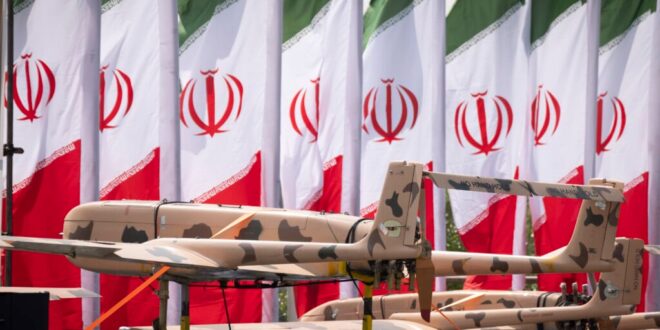As the Biden administration desperately tries to prevent or limit a missile and drone attack by Iran and its proxies against Israel, it would be wise to remember that the Middle East is already awash in Iranian projectiles. Recently, an Iranian artillery rocket fired by Lebanese Hezbollah killed twelve children in northern Israel, leading to an escalation spiral where the Israelis killed Hezbollah’s number two man, with the terror group now seeking revenge.
That initial strike followed a historic first long-range Unmanned Aerial Vehicle (UAV) strike by Yemen’s Houthi rebels against Tel Aviv, killing one person. The UAV was made in Iran and completed a 2,600 km flight path.
While forward-deployed long-range strike systems are an essential component of Tehran’s “ring of fire” strategy against Israel, that is not the only arms proliferation problem the administration must tackle. The Islamic Republic is capitalizing on a more permissive international environment to build on its track record of arms proliferation to non-state actors to become an arms salesman to states.
One way Iran can elicit state interest is by highlighting the role its low-cost systems, like drones, have played on the battlefield. The infamous Shahed-136 UAV—also called the Geran-2—has been instrumental in Russia’s ongoing war against Ukraine, with Moscow firing a reported 4,600 drones in the first two years of the conflict. The same drone also featured in Iran’s April 13 attack against Israel.
Far beyond Ukraine and Israel, Iranian drones have been seen in at least two other continents, demonstrating the radius of Iranian arms shaping international conflicts. In Venezuela, reporting from 2012 reveals Tehran aiding Caracas with local drone production. Fast forward to today, Venezuela’s armed forces utilize the Iranian Mohajer-2, dubbed the ANSU-100, as well as the newer ANSU-200, which closely resembles Iran’s Shahed-171. In Ethiopia, Iranian drones played a significant role in the war in the northern Tigray region, with the Ethiopian military deploying Mohajer-6 UAVs. Similarly, in Sudan’s civil war, Iran’s Mohajer-6 UAVs have aided the Sudanese Armed Forces in blocking the advance of the rival Rapid Support Force and regaining territory. Tehran may even be the source behind Pyongyang’s sudden embrace of airpower.
It should be no surprise then that drones were included in a recently reported $500 million arms pact between Iran and Armenia. While Yerevan and Tehran officially denied the deal, Iran’s rejection is likely driven by local considerations, namely, attempts to diplomatically rope-a-dope Baku.
This July, an Iranian parliamentarian touted a drastic increase in military exports over the last three years, noting that production grew two-and-a-half times while exports surged in the same period. The IRGC-affiliated Tasnim News highlighted that Tehran aims to take Turkey’s place in the global UAV market by 2028, striving to capture at least one-quarter of this market share, equivalent to around $6.5 billion.
Beyond supplying drones, Tehran has also facilitated capacity building for states interested in producing Iranian-designed UAVs. Iran inaugurated a drone production factory in Tajikistan in 2022 for the Ababil-2 UAV. While the status of this facility remains unclear, Russia has rushed ahead at the Alabuga Special Economic Zone to bring the Geran-2 online.
Another way Iran may seek to generate interest in its arms is through a ramped-up presence at defense exhibitions. In 2024, the Islamic Republic flaunted its military systems at booths in defense expos in Malaysia, Qatar, and Iraq and sent a delegation to participate in an expo hosted by Saudi Arabia. Moscow and Belgrade also had booths featuring Iranian defense manufacturers at shows the year prior.
With the exception of American and European sanctions, the Islamic Republic today faces no international restrictions for engaging in the global arms trade. This resulted from arms embargoes and missile testing and transfer prohibitions that lapsed in October 2020 and October 2023, respectively, as stipulated by UN Security Council Resolution 2231, which codified the 2015 Iran nuclear deal. While the existence of these prohibitions did not prevent Iran from attending regional arms expos, such as in Iraq in the past, nor did it prevent missile testing or arms transfers, it created an international predicate for multilateral action against Tehran and broadened the coalition for sanctions enforcement. When faced with the termination of these penalties, Iran scaled up these activities, believing them to be cost-free.
The growing global reach of Iranian arms necessitates the restoration of an international baseline to deter and punish prospective sales. But a new resolution at the UNSC against Iran’s arms exports is unlikely when a permanent member of the UNSC is benefitting from Iranian drones and may soon receive Iranian ballistic missiles as well. Prior to a mechanism in 2231 that reverse-engineers the UNSC veto expires in October 2025, Washington should work with its trans-Atlantic partners to restore permanent arms transfer and missile testing prohibitions, popularly called “snapback.”
From this baseline, Washington can move to aggressively sanction Iranian procurement rings and illicit networks that move money and parts for the Islamic Republic. Washington should also devote more resources to making sure Tehran is denied the benefits, particularly if they are monetary, of its increasingly global arms trade.
Creativity must also be embraced. This means more multilateral efforts to interdict or intercept arms transfers where possible, as well as more raising of the issue of Iranian arms transfers in bilateral relationships with countries hosting arms expos featuring Iranian weapons or with those who seek to purchase them.
Additionally, the United States and others should consider stemming the supply side of the equation through acts of sabotage against Iranian drones or other weapons production and storage facilities, as Israel was reported to have done in 2022.
If pursued in isolation, none of these ideas are likely to put the Iranian arms proliferation problem back in the box. However, taken together, they can handicap the Islamic Republic’s efforts to rise to the status of international arms salesman.
 Eurasia Press & News
Eurasia Press & News



